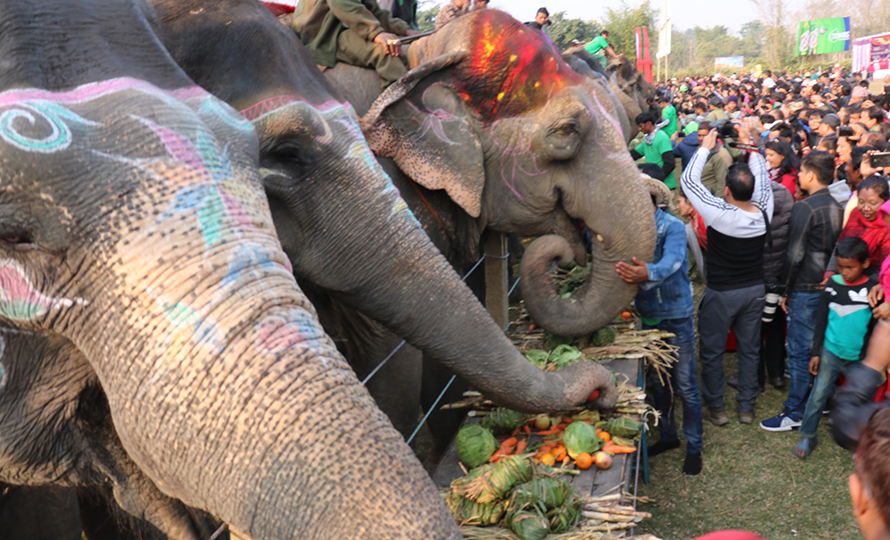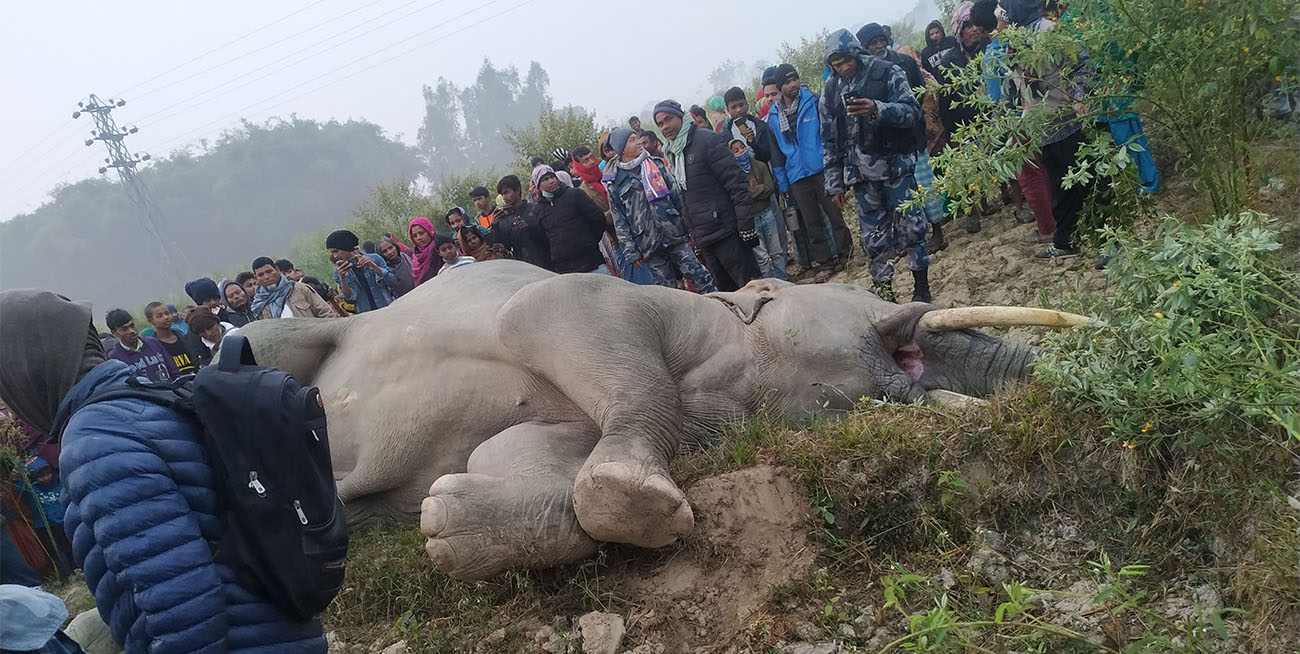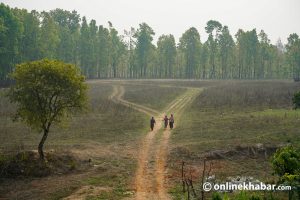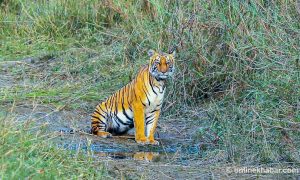The electrocution of a wild tusker at Khadak municipality in Sapatari district on January 9, 2021, has once again reminded us of the thorny problem of human-elephant conflict in Nepal. Local farmers who live on the fringe of forested areas are destined to face foraging wild Asian elephants (Elephas maximus), especially during the harvesting season. The said wild animal is reported to have been electrocuted at an electric fence erected by locals to prevent foraging elephants from entering into their crop fields and village.
Every year, we read news about marauding wild elephants causing crop damage and loss of property in villages that are on the fringe of forested areas. At times, such incidents end in the tragic loss of human life or the death of endangered wildlife. Then, the issue is settled and the matter is forgotten. But, for the locals, the conflict with wild elephants is a harsh reality. Villagers, whose crop fields are adjacent to forested areas that are used by resident and migrating elephant herds, are left with no choice but to face the foraging giants on their own to save their crop.
1. Plights of farmers
During the harvesting season, farmers are known to keep their vigil by staying on machans (watch towers) at night and making all sorts of noises such as shouting, beating drums and using firecrackers to discourage the foraging animals from entering their crop fields. In some Indian villages, farmers are also said to use the smoke of burning chilli pepper to thwart crop raid. Locals who live near the forested areas and do subsistence farming are the hardest hit.
The foraging giants are also known to enter deep into human habitation in search of food. Foraging elephants can be a real nuisance and cause damage to property and injure humans. Retaliatory actions by affected farmers sometimes lead to the death of the protected species. There is a provision of compensation for loss of human life or injury or damage to crop or property. Local Inhabitants living on the fringe of forested areas, however, have been continually experiencing the ordeal for decades.
2. A curious paradox
Human-elephant conflict presents a curious paradox. Nepal is internationally committed to biodiversity conservation and the wild Asian elephant is legally protected in the country. The killing of endangered wildlife is punishable by law. Conservationists are often in a dilemma while dealing with the situations relating to human-elephant conflict.
A few years ago, a rogue left a trail of death and destruction in Far-West Nepal before the authorities took the extreme measure and destroyed the problem animal. Conservationists do not want to be in such a situation when they have to make a decision to kill an animal they are professionally committed to protecting.
There is often news on wild elephants wreaking havoc in the eastern district of Jhapa, resulting in the loss of life and property worth millions of rupees. These marauding elephants are known to cross over the Mechi river and enter the Nepali side from the Indian forests across the border. The herds are said to be using the old forest corridor traditionally used by wild elephants during their seasonal movement.
Loss of human life in an encounter with a wild elephant is a great tragedy and human life must be protected at any cost. Park wardens coordinate with local authorities to arrive at such an unpleasant decision when the incidents occur outside the protected area. The fact that foraging wild elephants cover great distances during their seasonal migration makes the matter all the more complicated.

3. Degradation of elephant habitat
The pristine forests of lowland Terai of Nepal and the contiguous jungles in the north and north-east India once served as one large habitat for wild Asian elephants. Experts say the elephants of the two countries formed one large population. However, following the eradication of malaria in Nepal’s southern plains and the large scale deforestation for resettlement and agricultural development programmes of the government, there was an unchecked influx of hill people into the fertile land. It resulted not only in the loss of major slice of Nepal’s forest cover but also the prime wildlife habitat including that of the wild elephant.
Loss of pristine wildlife habitat saw the fragmentation of elephant population into smaller groups. Moreover, it narrowed the range of the long distances they used to traditionally cover in the past and confined them into comparatively smaller areas of degraded forests. Rapidly growing human population and the need for agricultural land for subsistence farming has further aggravated the situation. All these factors have made interface and conflict between locals and wild elephant inevitable.
4. Spatial status of wild elephant
According to a study carried out by Petra ten Velde in 1996-98 with the financial support of WWF, four main populations of wild Asian elephant have been recorded in Nepal, existing along with the eastern, central, western and far-western belts of the country. The eastern herd of 10-15 individuals migrates from West Bengal of India during the harvesting times of corn and rice. After crossing over to Nepal, this herd is known to proceed along the Churia foothills to the Sunsari and Saptari districts, before returning to the Indian side again.
A herd of approximately 25 elephants residing in Parsa Wildlife Reserve forms the central population. This population also uses Chitwan National Park as dispersing area.
The 40-50 resident population of Bardiya National Park forms the western population. This population has become resident since 1993. Likewise, the far-western population of 12-18 elephants lives within the Churiya foothills national forests, occasionally moving to the Indian forests, crossing over the Mahakali river.
There are altogether 208 domesticated (captive) elephants in the country, which are owned by the government, conservation agencies and individuals.
5. Loss of life and property
In terms of conflict and the resultant loss of life and property, eastern Nepal is the most affected. A study carried out by BR Yadav reports migrating wild elephants (from across the border) range from a few individuals to over 100 animals. Incidentally, the forest corridor used by migrating elephants in the area is also highly degraded and fragmented.
According to the Department of National Parks and Wildlife Conservation (Government of Nepal), an average household in Jhapa district loses up to Rs.30, 000 annually to wild elephants. The report further states that during the period between 2003 and 2007, 20 locals lost their lives in elephant attacks while 12 elephants were killed in retaliatory actions. In recent years, human casualties are said to be on the rise.
A relief scheme has been initiated by the government to compensate for the loss of life or injury sustained in elephant attacks.

6. Threats and conservation efforts
Wild elephants use a large area for their seasonal movement. It is said the contiguous forests from Assam of India to Nepal’s forests were once traditionally used by migrating elephant herds. In Nepal, the major problem lies in the fragmentation and degradation of the ancient forest corridor once used by the wandering terrestrial giants.
Apart from legally protecting wild elephants, the Government of Nepal has prepared an Elephant Conservation Action Plan and implemented the Terai Arch Landscape (TAL) Programme by joining hands with WWF Nepal. The TAL Programme is aimed at improving the chances of long-term survival of this endangered species in their current habitats with the restoration of degraded forest corridors, while also linking the adjacent protected areas of Nepal and India with a biological pathway through restoration and regeneration programmes. It mobilises local communities to achieve the goal through community development initiatives and by providing other incentives.
Wildlife knows no political boundaries and wildlife authorities of the two countries also meet occasionally to deal with problems relating to the trans-border movement of mega terrestrial giants.
7. Initiatives at site level
In order to minimise the conflict, the initiatives taken at the site level include construction of physical barriers such as wildlife watch towers and trenches together with the promotion of traditional deterring methods i.e., building fire and making noises to deter crop raid. Local people also team up with domesticated elephants in the process. Despite the adoption of the said deterring methods, foraging elephants seem to find newer ways of entering into the crop fields.
The government has initiated the erection of electric fences in critical areas by joining hands with local people. Its sustainability is yet to be seen. Local ownership is considered important in this regard.
Wildlife expert Dr Narendra B Pradhan states that retaliatory killing of marauding elephants has not reached a critical level in Nepal if compared with the situations in other South Asian countries. He, however, cautions that the likelihood of affected farmers’ patience running out could not be ruled out. An amicable settlement of disputes and long-term solution to this knotty problem should be sought before it is too late.
























